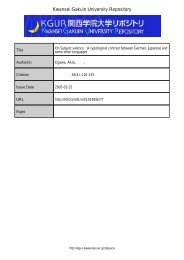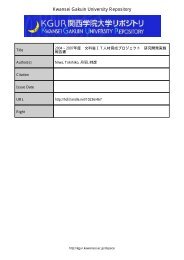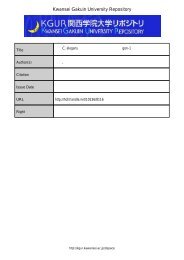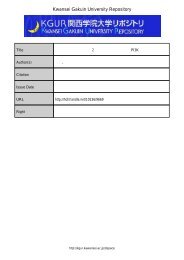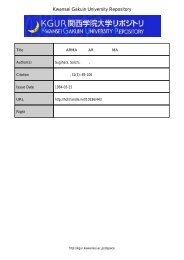Kwansei Gakuin University Repository
Kwansei Gakuin University Repository
Kwansei Gakuin University Repository
Create successful ePaper yourself
Turn your PDF publications into a flip-book with our unique Google optimized e-Paper software.
5.2. Estimation results<br />
Using the CPH model, we estimate the determinants of exit according to forms of<br />
exit. The definition of the variables and descriptive statistics are shown in Tables 3<br />
and 4, respectively. Table 5 shows the estimation results by forms of exit. Column<br />
(i) of Table 5 shows the results using a pooled sample of all forms of exit, in order<br />
to compare the pooled results with each form of exit separately. In Column (i) of<br />
Table 5, the industry’s price–cost margins (P CM) and gross entry rate (ENT RY )<br />
have significantly negative and positive effects on the hazards of the pooled exit,<br />
respectively. However, other independent industry-specific characteristics have no<br />
significant effects on the hazards of exit. Region-specific characteristics have no sig-<br />
nificant effects on the hazards of exit in Column (i) of Table 5. With respect to<br />
firm-specific characteristics, SIZE_5-9 and SIZE_10-19 have negative and signif-<br />
icant effects on the hazards of pooled exit, although the effect of SIZE_20 is not<br />
significant. This suggests that there is a nonlinear relationship between firm size<br />
and exit. The dummy variable for joint stock companies (JST OCK) has a signifi-<br />
cantly positive effect, although this is simply included as a control variable. As for<br />
entrepreneur-specific characteristics, the variables for educational background and<br />
age have significant effects on the pooled exit results, indicating that firms whose<br />
entrepreneurs had a university education and were approaching retirement age were<br />
more likely to exit.<br />
Columns (ii)–(iv) of Table 5 show the estimation results for the determinants<br />
of exit of new firms by forms of exit. The variable for capital intensity (CAP ), as<br />
shown in Column (ii) of Table 5, has negative and significant effects on exit through<br />
bankruptcy. This result indicates that new firms tend to survive longer in capital-<br />
intensive industries. On the other hand, Columns (iii)–(iv) of Table 5 indicate that<br />
CAP has positive and significant effects on voluntary liquidation and merger, sug-<br />
gesting that new firms are more likely to exit through voluntary liquidation and<br />
20



